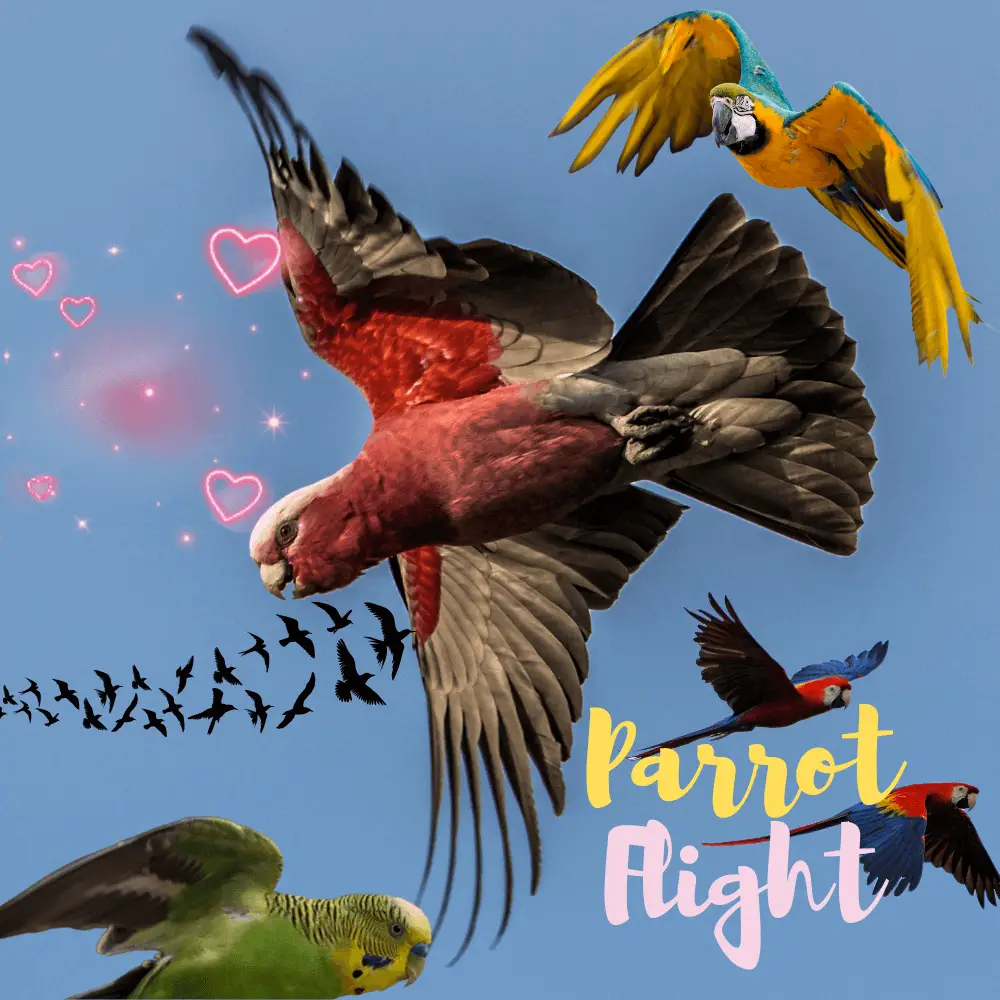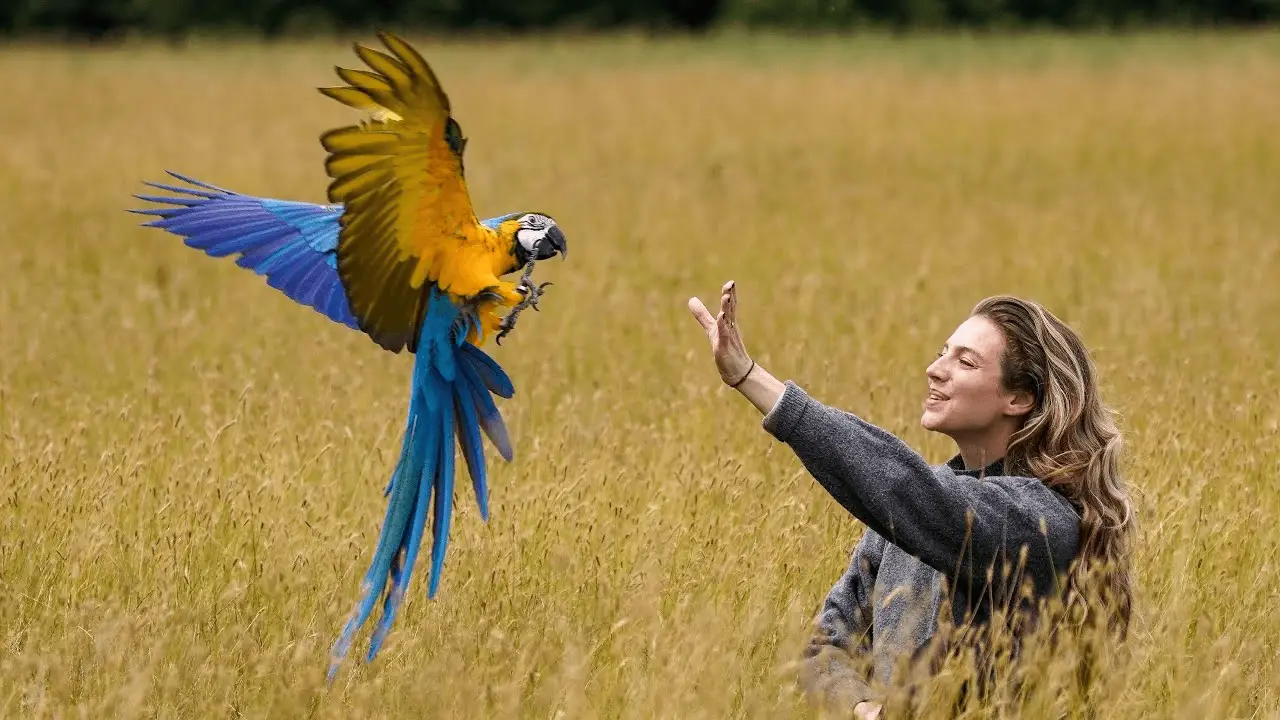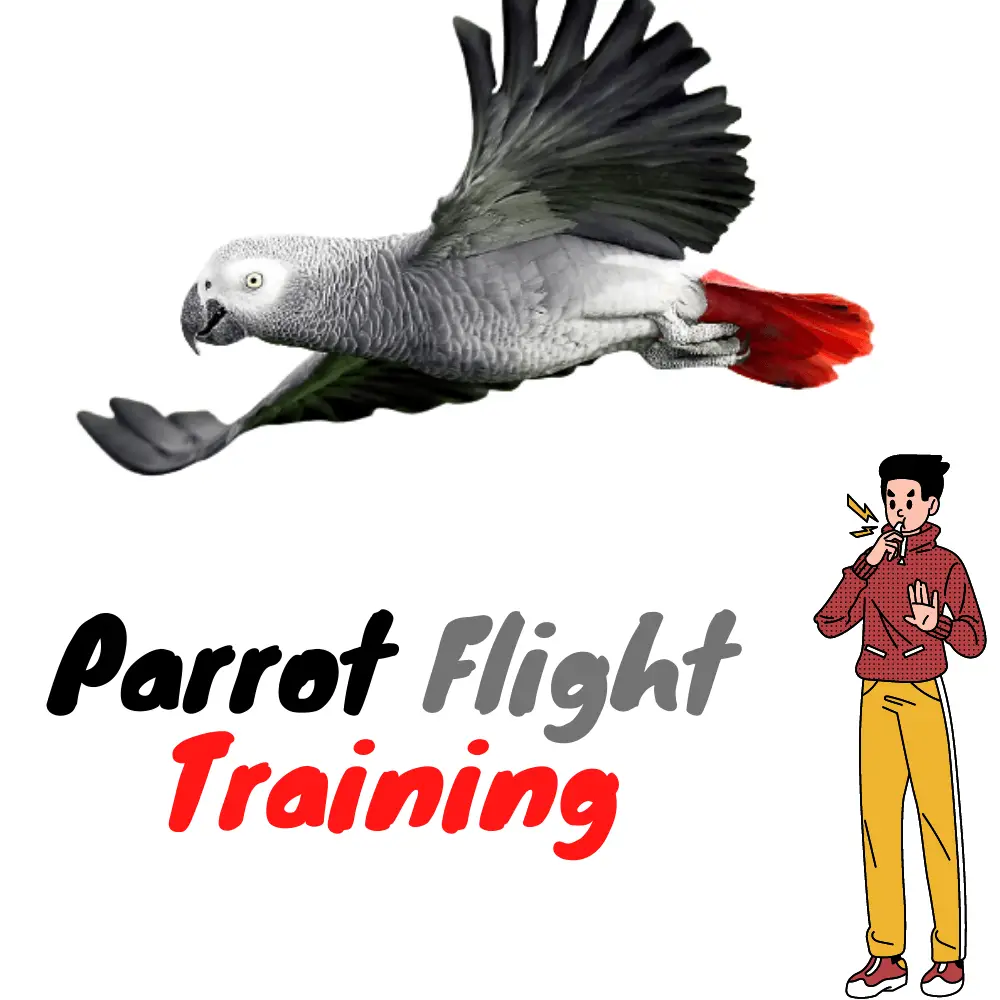
Parrot flying: This creature is intelligent and social it’s known for its ability to fly. If you’re interested in teaching a parrot to fly, here are some steps you can follow:
- Make sure the parrot is healthy and physically ready to fly. This typically occurs when a parrot is around 6-12 months old, but it can vary depending on the species.
- Begin by encouraging the parrot to fly short distances in a controlled environment, such as a room or a small aviary.
- Use positive reinforcement, such as offering treats or praise, to encourage the parrot to fly.
- Gradually increase the distance and complexity of the flight path as the parrot becomes more comfortable and confident in its flying ability.
- Make sure the parrot has access to perches and other objects to land on, and provide a safe place for the parrot to retreat to if it becomes scared or overwhelmed.
- Always supervise the parrot when it is flying to ensure its safety.
It’s important to remember that every parrot is different and may learn to fly at its own pace. Patience and consistent training are key to helping a parrot learn to fly.
Can you free-fly parrot?
Free flight is a type of training that allows parrots to fly freely without being tethered or confined to a specific area. While it can be an enjoyable and enriching activity for parrots, it also carries some risks and requires careful planning and supervision.
In order to free-fly a parrot, you will need to ensure that the parrot is physically ready for free flight and has been trained to fly short distances in a controlled environment. You will also need to choose a safe location for the parrot to fly, such as a large, enclosed outdoor aviary or a room with windows that can be opened for the parrot to fly in and out of.
It’s important to remember that free flight is not suitable for all parrots and requires careful planning and supervision. It’s also important to consider the risks and potential dangers associated with free flight, such as the possibility of the parrot flying into objects or getting lost. Pet owners should carefully weigh the risks and benefits of free flight and make an informed decision about whether it is the right activity for their parrot.

Parrot-free flight training
Free flight is a type of training that allows parrots to fly freely without being tethered or confined to a specific area. It can be an enjoyable and enriching activity for parrots, but it also carries some risks and requires careful planning and supervision. Here are some steps you can follow to teach a parrot-free flight:
- Make sure the parrot is physically ready for free flight. This typically occurs when a parrot is around 6-12 months old, but it can vary depending on the species.
- Begin by training the parrot to fly short distances in a controlled environment, such as a room or a small aviary. This will help the parrot build its flying muscles and gain confidence in its ability to fly.
- Use positive reinforcement, such as offering treats or praise, to encourage the parrot to fly.
- Gradually increase the distance and complexity of the flight path as the parrot becomes more comfortable and confident in its flying ability.
- Choose a safe location for the parrot to fly, such as a large, enclosed outdoor aviary or a room with windows that can be opened for the parrot to fly in and out of.
- Supervise the parrot at all times during the free flights to ensure its safety.
- If the parrot becomes lost or flies too far away, use calls and treats to encourage it to return.
It’s important to remember that free flight is not suitable for all parrots and requires careful planning and supervision. It’s also important to consider the risks and potential dangers associated with free flight, such as the possibility of the parrot flying into objects or getting lost.

Which parrot is best for a free flight?
Free flight is a type of training that allows parrots to fly freely without being tethered or confined to a specific area. While it can be an enjoyable and enriching activity for parrots, it also carries some risks and requires careful planning and supervision.
When considering which parrot is best for free flight, it’s important to consider the size, weight, and flying ability of the bird. Larger, heavier parrots may not be able to fly as easily as smaller, lighter parrots, and may be at greater risk of injury if they collide with objects or surfaces.
It’s also important to consider the natural habitat and behavior of the parrot. Some parrot species are more adapted to flying long distances and may be more suitable for free flight, while others may be more suited to life in an aviary or cage.
Some parrot species that may be well-suited for free flight include:
- African grey parrots
- Amazon parrots
- Cockatoos
- Conures
- Macaws
It’s important to remember that every parrot is different and that the suitability of free flight will depend on the individual bird’s size, weight, flying ability, and natural habitat and behavior. Pet owners should carefully consider the risks and benefits of free flight and make an informed decision about whether it is the right activity for their parrot.

How long does it take to train a bird to free fly?
The amount of time it takes to train a parrot to free fly can vary greatly depending on the individual bird’s size, weight, flying ability, and natural habitat and behavior. Some parrots may take to free flight more quickly than others and may be able to fly relatively long distances after only a few weeks of training, while others may take longer to build their flying muscles and gain confidence in their ability to fly.
In general, it’s a good idea to start training a parrot to free fly gradually, beginning with short flights in a controlled environment and gradually increasing the distance and complexity of the flight path as the parrot becomes more comfortable and confident in its flying ability.
It’s also important to use positive reinforcement, such as offering treats or praise, to encourage the parrot to fly. Consistent training and patience are key to helping a parrot learn to free fly.
It’s a good idea to consult with a veterinarian or a bird behavior specialist for guidance on training a parrot to free fly. They can help you determine the best approach for your specific parrot and can provide advice on how to safely and effectively train the bird to fly.
what is the best place to free-fly a parrot?
The best place to free-fly a parrot is an outdoor location that is safe and spacious, with a variety of perches and trees for the parrot to land on. It’s important to choose a location that is free from potential dangers such as traffic, predators, and other hazards. It’s also a good idea to choose a location that is relatively quiet and free from distractions so that the parrot can focus on flying and exercising. It’s important to supervise the parrot at all times while it is free flying to ensure its safety.
Parrot flying speed
The flying speed of a parrot can vary depending on the size and species of the parrot, as well as the conditions in which it is flying. Some smaller parrots, such as budgies and lovebirds, can fly at speeds of up to 25 mph (40 km/h). Larger parrots, such as macaws and cockatoos, can fly at speeds of up to 35 mph (56 km/h). These are just rough estimates, and actual flying speeds can vary widely depending on the specific parrot and the circumstances in which it is flying. In general, parrots are agile and quick in flight and are able to make sharp turns and sudden movements to avoid obstacles and predators.
How high can a parrot fly
The maximum height that a parrot can fly can vary depending on the size and species of the parrot, as well as the conditions in which it is flying. Some smaller parrots, such as budgies and lovebirds, can fly at heights of up to 100 feet (30 meters). Larger parrots, such as macaws and cockatoos, can fly at heights of up to 300 feet (90 meters) or more. These are just rough estimates, and actual flying heights can vary widely depending on the specific parrot and the circumstances in which it is flying. In general, parrots are strong and capable fliers and are able to soar to great heights in the right conditions.
How far can parrots fly without stopping?
The distance that a parrot can fly without stopping can vary depending on the size and species of the parrot, as well as the conditions in which it is flying. Some parrots, such as budgies and lovebirds, may be able to fly for several miles without stopping, while larger parrots, such as macaws and cockatoos, may be able to fly for even longer distances. However, it’s important to keep in mind that parrots are not migratory birds and do not typically fly long distances for extended periods of time. Most parrots will stop to rest and feed frequently during the flight, and will only fly for as long as they are able to do so comfortably. In general, parrots are strong and capable fliers and are able to cover significant distances when they need to, but they do not have the same endurance as some other types of birds.
Why do parrots scream when they fly?
There are a few possible reasons why parrots might scream when they fly. One possibility is that the parrot is excited or nervous about flying. Some parrots may scream when they are flying as a way of communicating their excitement or anxiety to their human companions. Another possibility is that the parrot is trying to communicate with other birds or animals in the area. Parrots are social animals and may use vocalizations to communicate with other members of their flock or with other animals. Finally, it’s possible that the parrot is simply enjoying itself and making noise for the sake of it. Some parrots are known to be vocal and may make noise simply because they are having fun. It’s important to keep in mind that each parrot is an individual, and the specific reason for its vocalizations may be different in each case.
Dangers of Free Flight for Your Parrots
Free flight is a type of training that allows parrots to fly freely without being tethered or confined to a specific area. While it can be an enjoyable and enriching activity for parrots, it also carries some risks that pet owners should be aware of:
- Risk of injury: Parrots can collide with objects or surfaces while flying, which can result in injuries ranging from bruises and scratches to broken bones.
- Risk of getting lost: If a parrot flies too far away or becomes disoriented, it may become lost and be unable to find its way back home.
- Risk of predation: In some areas, parrots may be at risk of predation from birds of prey or other animals.
- Risk of exposure to toxins: Parrots that fly outside may be exposed to toxins such as pesticides or other harmful substances.
- Risk of escape: If a parrot is able to fly outside of its enclosure or aviary, it may be able to escape and become lost or injured.
It’s important to carefully consider the risks associated with free flight and to take steps to minimize them. This may include providing a safe, enclosed space for the parrot to fly in, supervising the parrot at all times, and training the parrot to return to a designated location on command.
What happens if your parrot flies away?
If your parrot flies away, it’s important to act quickly and try to locate the bird as soon as possible. Here are some steps you can take if your parrot flies away:
- Call the parrot’s name and make a noise to try to get its attention.
- Look for the parrot in nearby trees, bushes, and other places it might have landed.
- Ask neighbors and passersby if they have seen the parrot.
- Check local animal shelters and post flyers in the area to try to locate the parrot.
- Consider offering a reward for the return of the parrot to increase the chances of it being found.
If you are unable to locate the parrot, it’s important to continue searching and to keep an eye out for the bird in case it returns on its own. It’s also a good idea to consider measures to prevent the parrot from flying away again in the future, such as providing a secure enclosure or aviary and keeping windows and doors closed when the parrot is outside of its enclosure.




















